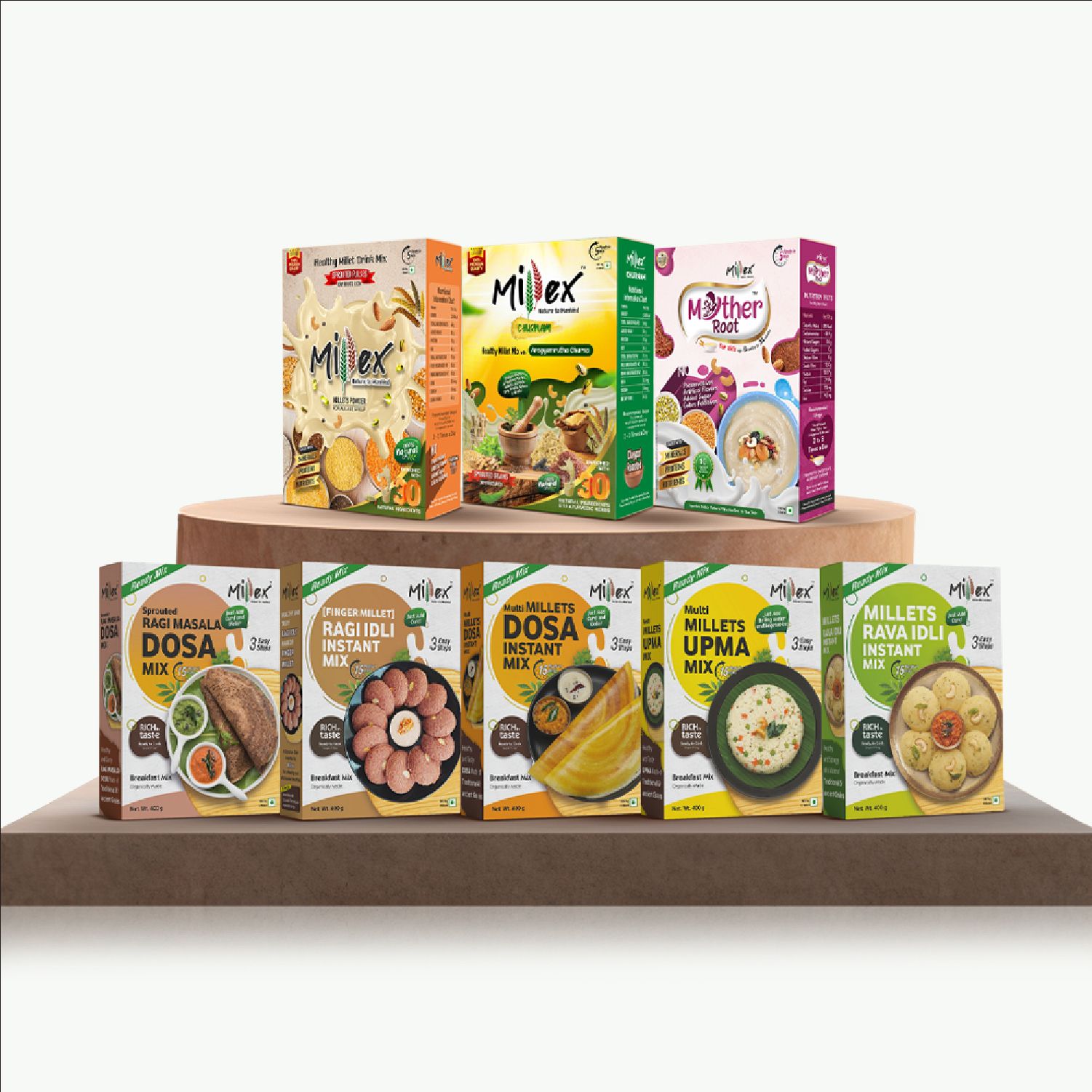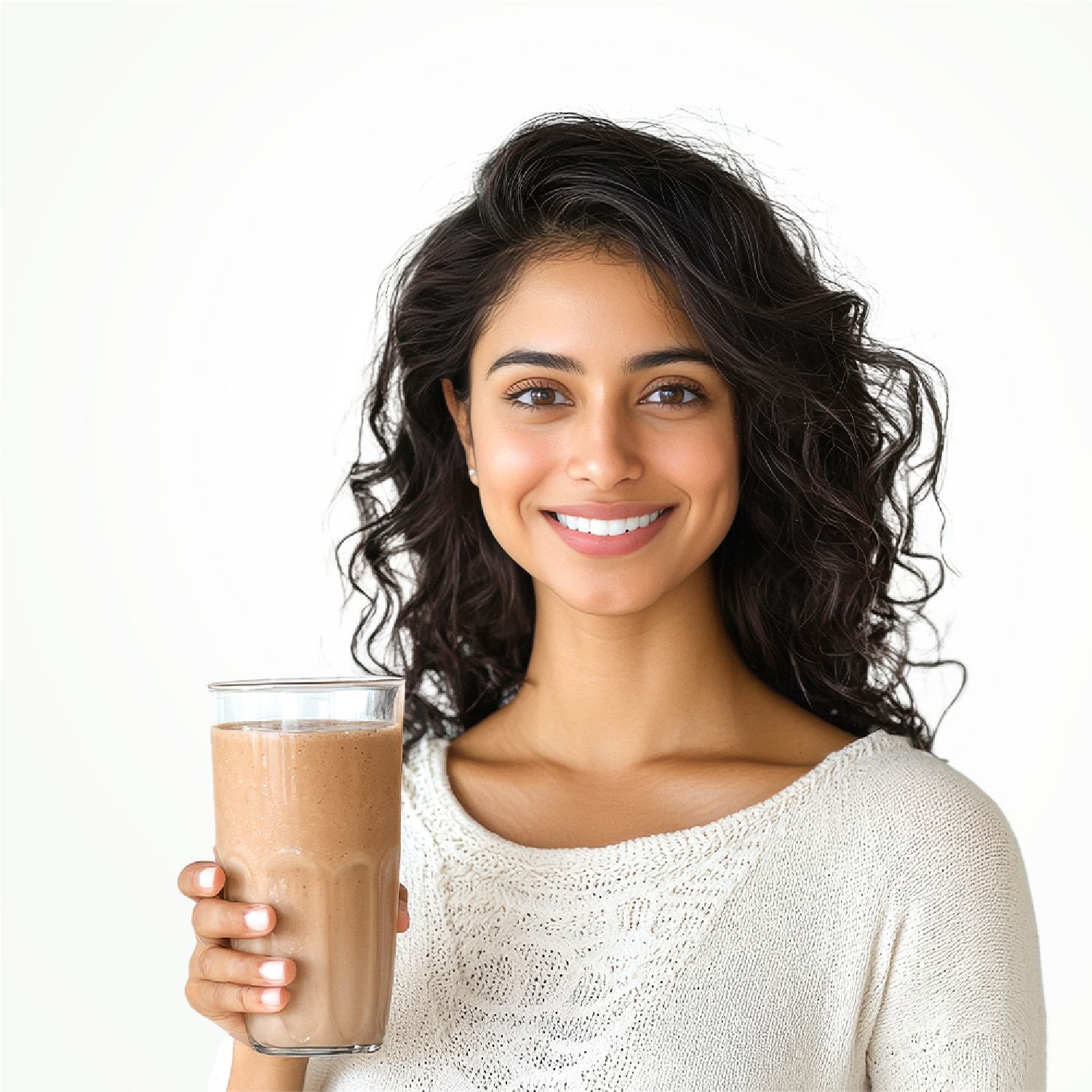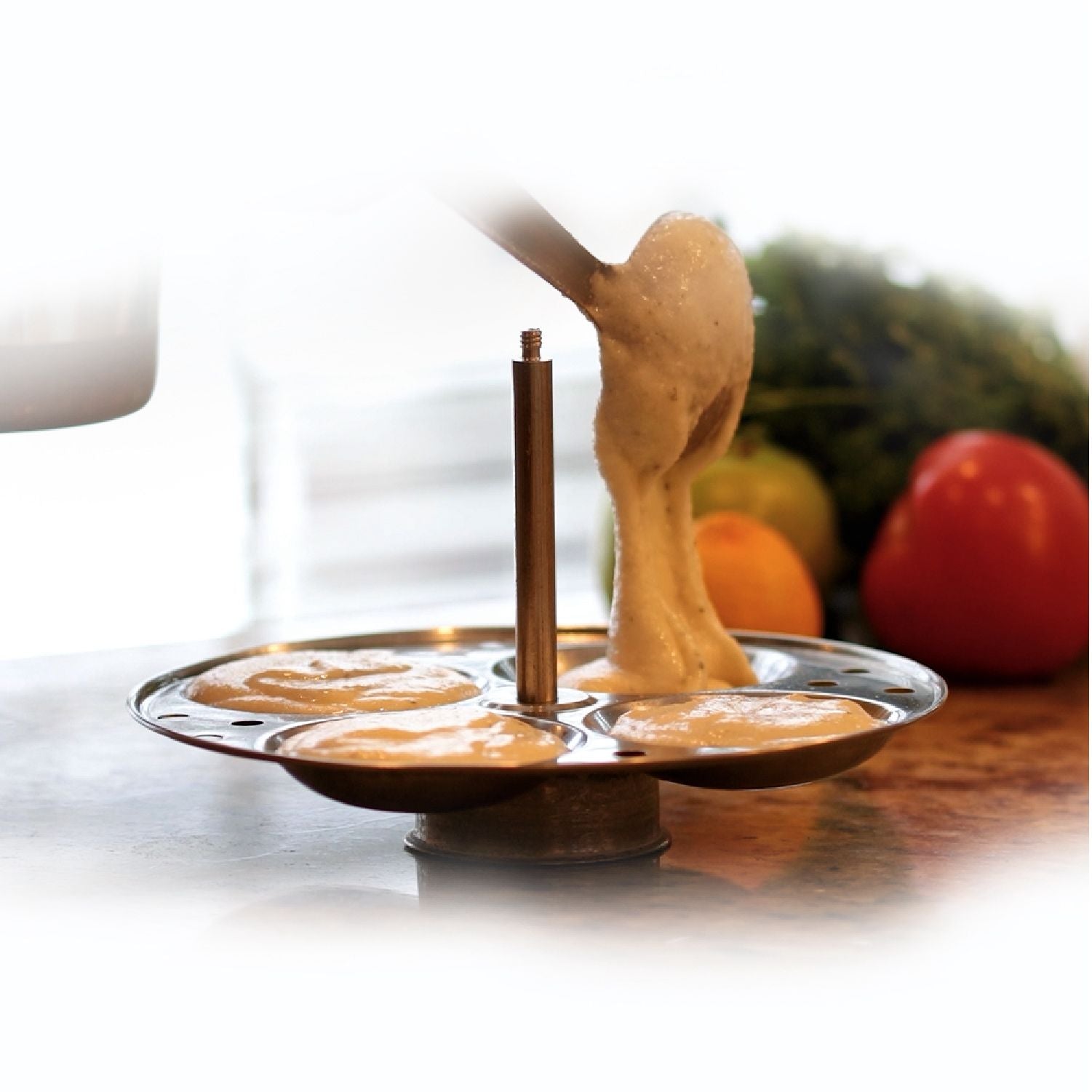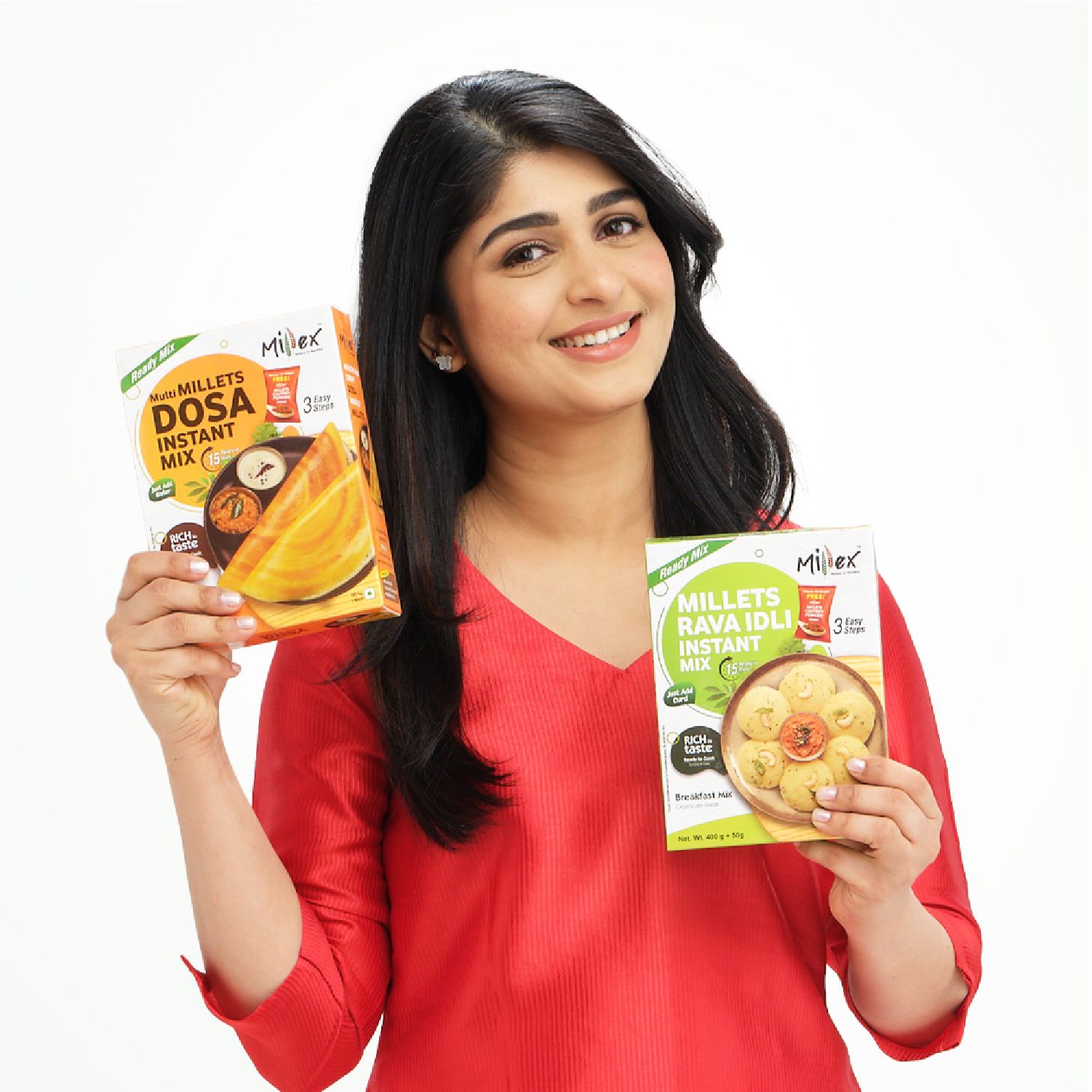Millet Dosa vs Regular Dosa: The Calorie & Protein Comparison You Need
Who says no to dosa when you are in South India? Dosa is the crispy, golden-brown delight from South India that has found its place in kitchens worldwide. The traditional dosa is common in every household of south Indians as it is prepared from a fermented batter of rice and urad dal, and millet dosa has been emerging as a healthier version of the traditional dosa which contains healthy millets other than just rice and urad dal. But what is the difference between these two versions in terms of nutrition? Let us take a closer look into it and settle the debate of Millet Dosa vs. Rice Dosa, which one comes out on top?

What Is Traditional Dosa And Millet Dosa?
Before deciding on which is best in nutrition, let’s first understand what exactly is traditional dosa and millet dosa:
· Traditional Dosa:
No one can escape the indescribable crispy taste of dosa. The classic dosa batter consists of two main ingredients called rice and urad dal. The batter is soaked, ground, and fermented overnight, resulting in a slightly tangy, nutritious base for making dosas. Traditional dosas are usually served with side dishes like coconut chutney, sambar, and various spiced powders. The fermentation enhances the dosa’s digestibility and flavor, making it a comfort food for many people.
· Millet Dosa:
Millet dosa uses one or more varieties of millets in the place of rice, like ragi or finger millet, bajra or pearl millet, or foxtail millet or little millet. Millets are very old grains known for their very good nutritional profile and sustainability nature. Millet dosas are also prepared the same way as dosa but the millets can be combined with urad dal or any other lentils for more taste and texture. The use of millets brings an added nutty flavor along with a huge amount of nutrients, these benefits of millet dosa makes it a great modern version of a traditional recipe.
Nutrition Comparison
Now, let us compare these two dosa types on some significant nutritional aspects:
1 Serving of Traditional Dosa Contains
· Calories – 120
· Protein – 3 – 4 grams
· Carbohydrates – 20 grams
· Fiber – 1 gram
· Iron – Low
· Calcium – Moderate
· Glycemic Index – High
1 Serving of Millet Dosa Contains
· Calories – 100 – 110
· Protein – 4 – 5 grams
· Carbohydrates – 15 – 18 grams
· Fiber – 2 – 3 grams
· Iron – Usually high but varies from millet type
· Calcium – High especially with ragi
· Glycemic Index – Low to Moderate
These values show the differences in calorie density, glycemic index, and the huge boost in micronutrients that millets bring to your body. The higher fiber content in millet dosa is particularly the best option for those who are aiming to improve digestive health or manage weight.
Key Benefits of the Traditional Dosa and the Millet Dosa:

Traditional Dosa:
· Energy Booster:
The carbohydrates in traditional dosa are quickly absorbed by the body, making it an excellent option for a morning energy boost or as fuel for physical activity. It provides a steady supply of energy for busy days.
· Digestive Health:
Fermentation of the batter enhances probiotic content, which supports gut health. The process also breaks down anti-nutrients, making the dosa easier to digest and the other nutrients can help to improve your digestive health.
· Variety of Flavor Profile:
Traditional dosa is very much in harmony with almost all kinds of accompaniments, whether coconut chutney or sambar, offering an incredible taste and scope to combine it in a lot of flavors according to your own choice.
· Quick Preparation:
Once the batter gets fermented, it can be stored and used to make other dishes like uttapam, paniyaram and idli which makes it more convenient for you to prepare healthy dishes every morning without wasting much time.
Millet Dosa:
· Low Glycemic Index:
Millets slow down the release of sugar into the blood, thus it helps to manage diabetes and prevent energy crashes. This benefit of Ragi dosa makes it suitable for people monitoring their blood sugar levels and maintaining weight balance.
· High Fiber Content:
The dietary fiber in millets promotes better digestion, reduces cholesterol levels, and enhances feelings of fullness, aiding in weight management and reduce the risk of overeating. As it controls your hunger, you won’t each much and gain weight easily.
· Rich in Micronutrients:
Micronutrient benefits vary with each type of millet. For instance, ragi is quite high in calcium content while the foxtail millet contains spectacular amount of iron content. These ensure strong bones, better oxygen transport, and a good immune system.
· Gluten Free:
Millets are gluten-free in nature, thus it aids to some people's intolerance against gluten or celiac disease. Millet dosa can be the preferred dosa for a more accommodating diet. Opting for millet dosa supports sustainable farming practices and reduces environmental impact.
· Affordable Dosa Option:
To inculcate the millet’s nutrition in your body, millet dosa is one of the best affordable options for you. Millet dosa is budget-friendly and relies on ingredients that are widely available, making it a deeply satisfying dosa option.
· Customizable and Nutritious Blends:
The batter can be customized by combining different millets and lentils, enhancing both taste and nutritional value. Adding spices like cumin or curry leaves can also elevate the millet dosa nutritional value, flavor and health benefits.
· Weight Management:
The low-calorie and high-fiber profile of millet dosa makes it ideal for weight-conscious people. It keeps you fuller for longer periods, which naturally reduces unnecessary snacking.
· Heart Health:
Millets contain high magnesium, which ensures blood pressure control. The fiber content of millets also ensures cholesterol management and reduces the risk of heart diseases.
How to Make the Traditional Dosa Recipe?
Ingredients Required to Make Traditional Dosa:
· 1 cup rice which can be regular or parboiled
· 1/2 cup urad dal (black gram)
· 1/4 tsp fenugreek seeds
· Salt for additional taste
· Add water as required
Step-by-Step Process:
· Rinse and soak rice, urad dal and methi seeds in water for 4 to 6 hours.
· Grind the soaked mixture into a smooth batter by slowly adding water
· Let the batter ferment overnight or for 8 to 12 hours in a warm place.
· Add salt to the fermented batter and mix well so the salt will dissolve.
· Heat a non-stick or cast-iron pan and add a ladle of batter to the center of the pan. Spread it in a circular motion and make it a very thin layer.
· Add a few drops of oil around the edges and cook till golden brown.
· Serve hot with coconut chutney and sambar.
How to Make the Millets Dosa Recipe?
Ingredients Required to Make Millets Dosa Recipe:
· 1 cup mixed millets, ragi, foxtail, pearl or little millet or millex multi millet instant dosa mix.
· 1/2 cup urad dal (black gram)
· 1/4 tsp fenugreek seeds
· Salt to taste
· Take water as needed
Step-by-Step Process:
· Wash and soak millets, urad dal, and fenugreek seeds in water for 4-6 hours.
· Grind the mixture into a smooth batter, adding water as needed.
· Let the batter ferment overnight (8-12 hours).
· Add salt to the fermented batter and stir well.
· Heat a pan and pour a ladle of batter, spread it thinly.
· Drizzle oil around the dosa and cook until crispy.
· Serve with tomato chutney, peanut chutney, or sambar.
Who Should Choose Traditional Dosa?
· Suitable for those in need of instant energy or just for the nostalgia of the classic taste and texture.
· It suits people who don't have specific dietary restrictions or health issues.
· Children, athletes, and other high-energy requiring people may enjoy the traditional dosa more.
· Ideal for old comfort food and pairing with typical accompaniments.
Who Should Choose Millet Dosa?
· Good for health-conscious people who try to control their weight, blood sugar, or cholesterol.
· A great option for those with gluten sensitivity or people looking for nutrient-dense, gluten-free foods.
· Recommended for someone who is mindful of sustainable, eco-friendly food choices.
· For someone looking to add variety to their diet or someone interested in exploring ancient grains combined with modern recipes, multi millet dosa is perfect.

BUY NOW
Choose Your Favorite Dosa Mix From Millex And Start Enjoying It Now!
Both traditional and millet dosas have unique advantages. Where traditional dosa is a great comfort food high in energy and probiotics, millet dosa wins in overall nutrition and health benefits. Furthermore, Millex is the best choice to get your perfect multi millet dosa mix. You can now get the multi millet dosa instant mix at just Rs. 378. Our multi millet dosa mix is packed with vitamins, minerals, and proteins to support balanced nutrition and help in maintaining healthy blood sugar levels. Millex also have some other healthy dosa alternatives like ragi dosa mix for you to enjoy the crispiness of dosa without sacrificing your health.






